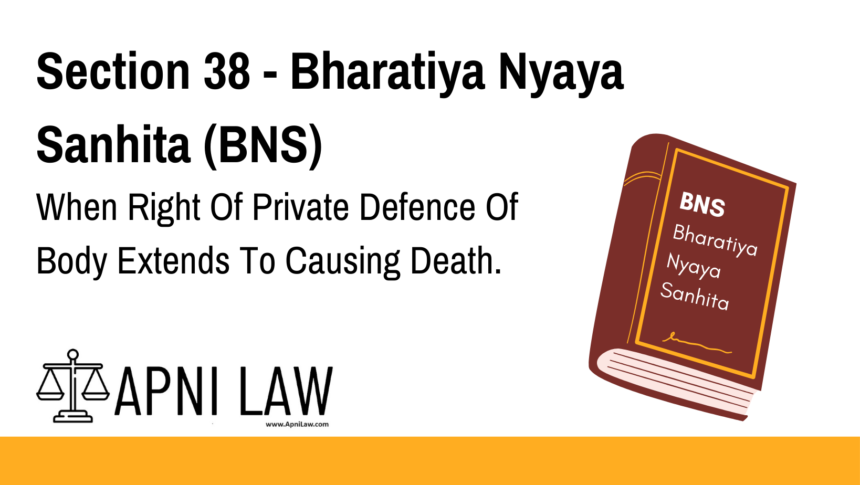Code: Exact Text of Section 38 BNS
Section 38 BNS
The right of private defence of the body extends, under the restrictions specified in
section 37, to the voluntary causing of death or of any other harm to the assailant, if the
offence which occasions the exercise of the right be of any of the descriptions hereinafter
enumerated, namely:—
(a) such an assault as may reasonably cause the apprehension that death will
otherwise be the consequence of such assault;
(b) such an assault as may reasonably cause the apprehension that grievous
hurt will otherwise be the consequence of such assault;
(c) an assault with the intention of committing rape;
(d) an assault with the intention of gratifying unnatural lust;
(e) an assault with the intention of kidnapping or abducting;
(f) an assault with the intention of wrongfully confining a person, under
circumstances which may reasonably cause him to apprehend that he will be unable to
have recourse to the public authorities for his release;
(g) an act of throwing or administering acid or an attempt to throw or administer
acid which may reasonably cause the apprehension that grievous hurt will otherwise
be the consequence of such act
Explanation of Section 38 BNS
1. When Can a Person Kill in Self-Defence?
Section 38 of BNS lays out specific situations where a person can use deadly force in self-defence. The key conditions include:
- A genuine threat to life or grievous harm.
- Serious criminal acts such as rape, kidnapping, and acid attacks.
- Situations where escape or legal help is impossible.
2. Why Does the Law Allow Killing in Some Cases?
- Protects innocent victims from extreme harm.
- Prevents serious crimes like rape, acid attacks, and kidnapping.
- Recognizes that in extreme cases, self-defence is the only option.
Illustrations
Example 1: Attacked with a Deadly Weapon
🔹 Scenario: A robber attacks a shopkeeper with a knife. The shopkeeper shoots the robber in self-defence.
✅ Justified: The shopkeeper had a reasonable fear of death.
Example 2: Woman Resisting an Acid Attack
🔹 Scenario: A man tries to throw acid on a woman. She stabs him with a knife, causing his death.
✅ Justified: Acid attack is a life-altering crime, and she acted to prevent grievous harm.
Example 3: Kidnapping at Gunpoint
🔹 Scenario: A man is forced into a car at gunpoint. He grabs the attacker’s gun and shoots him.
✅ Justified: Kidnapping is a crime where deadly force is allowed.
Example 4: Attempted Rape in an Isolated Area
🔹 Scenario: A woman is assaulted by a man attempting rape. She hits his head with a rock, causing his death.
✅ Justified: Self-defence against rape is legal.
Common Questions and Answers on Section 38 BNS
1. Can I kill someone in self-defence?
✅ Yes, but only in extreme situations where your life or safety is in danger, such as murder attempts, rape, or acid attacks.
2. What if I kill someone by mistake while defending myself?
✅ If you had a genuine reason to fear for your life, it may still be justified under private defence laws.
3. Do I need to prove self-defence in court?
✅ Yes, you must prove that your life or body was in danger and that you had no option but to use deadly force.
4. Can self-defence apply to family members?
✅ Yes, if a person is protecting their family from harm, they can use deadly force if necessary.
5. What if the attacker was unarmed?
🚫 If the attacker was not a serious threat to life or safety, using deadly force may not be justified.
Conclusion
Section 38 BNS allows lethal self-defence in life-threatening situations. It ensures that victims of violent crimes like attempted murder, rape, acid attacks, and kidnapping have the legal right to protect themselves. However, this right is not absolute, and courts examine each case carefully.
For more legal insights, visit ApniLaw today! 🚀








